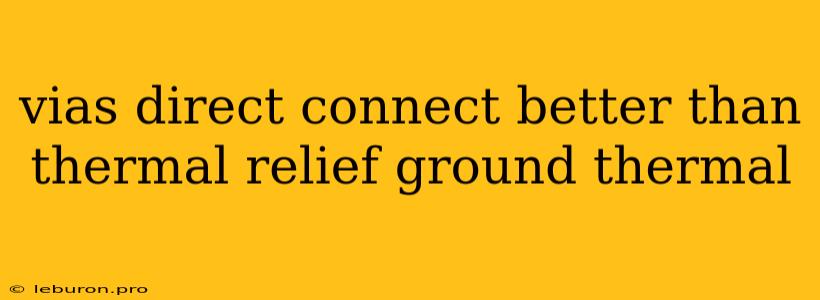The design of printed circuit boards (PCBs) is a complex and multifaceted process that requires careful consideration of numerous factors, including the choice of appropriate routing techniques. One crucial aspect of PCB design is the implementation of ground connections, which play a critical role in ensuring signal integrity and overall board performance. While thermal relief ground connections are widely used in many designs, vias direct connect offers several advantages that make it a superior option in certain situations. This article will delve into the benefits of vias direct connect compared to thermal relief ground, exploring its strengths in achieving optimal signal integrity, reduced impedance mismatch, and improved power delivery.
Understanding Vias Direct Connect and Thermal Relief Ground
Vias direct connect, also known as direct connect vias, is a routing technique where a signal trace is directly connected to a ground plane through a via without any intervening thermal relief structure. This method eliminates the transition from trace to ground plane, ensuring a continuous path for the current flow. Conversely, thermal relief ground involves using small gaps or interruptions in the ground plane to create a thermal relief structure. This structure allows the ground plane to expand and contract with temperature changes, mitigating stress and potential delamination.
The Advantages of Vias Direct Connect: A Deeper Dive
Enhanced Signal Integrity
One of the primary advantages of vias direct connect is its ability to enhance signal integrity. By eliminating the transition from trace to ground plane, vias direct connect reduces the potential for impedance mismatch. This is particularly important for high-speed signals, where even small impedance variations can lead to signal reflections and distortion. The absence of a thermal relief structure ensures a consistent impedance along the signal path, minimizing signal degradation.
Minimized Power Delivery Losses
Vias direct connect contributes to improved power delivery efficiency by creating a direct path for current flow. The absence of thermal relief structures reduces the overall resistance and inductance in the power path, enabling more efficient power distribution. This is particularly beneficial for applications requiring high power consumption, where minimizing voltage drops and maximizing power efficiency are critical.
Reduced EMI and Crosstalk
Vias direct connect can effectively reduce electromagnetic interference (EMI) and crosstalk between signal traces. The direct connection between the signal trace and ground plane provides a low-impedance path for current flow, minimizing the generation of electromagnetic noise. This is especially important for applications requiring high signal integrity and sensitive to EMI.
Improved Thermal Performance
While thermal relief ground is designed to mitigate thermal stress, vias direct connect can also contribute to better thermal performance. By providing a direct path for heat dissipation, vias direct connect can help to distribute heat more effectively, potentially reducing overall board temperatures. However, it is important to note that thermal performance is influenced by factors such as the size and density of vias and the surrounding components.
Considerations for Choosing Vias Direct Connect
While vias direct connect offers several advantages, it is not always the optimal choice for every design. There are some considerations to keep in mind when deciding whether to use vias direct connect or thermal relief ground:
Design Complexity
Vias direct connect can sometimes increase design complexity, especially for intricate layouts. The absence of thermal relief structures may require more precise placement and routing, which can be challenging for complex designs.
Manufacturing Challenges
Vias direct connect may pose some manufacturing challenges, particularly for high-density boards. The increased density of vias can increase the risk of manufacturing defects, such as short circuits or open circuits. Careful planning and consideration of manufacturing tolerances are crucial for successful implementation of vias direct connect.
Cost Considerations
Vias direct connect may be more expensive than thermal relief ground due to the increased number of vias required and the potential for more complex manufacturing processes. However, the benefits of vias direct connect in terms of signal integrity, power delivery, and EMI reduction can often outweigh the additional cost, especially for critical applications.
Applications of Vias Direct Connect
Vias direct connect is particularly well-suited for applications where high signal integrity, power delivery efficiency, and EMI mitigation are paramount. These applications include:
- High-speed digital circuits: Vias direct connect is essential for achieving high-speed signal transmission without degradation or reflections.
- Power distribution systems: Vias direct connect helps minimize voltage drops and improve power delivery efficiency, especially for high-power applications.
- High-frequency circuits: The low impedance path provided by vias direct connect reduces the generation of noise and improves overall signal quality in high-frequency applications.
Conclusion
While thermal relief ground remains a widely used routing technique, vias direct connect offers a compelling alternative that delivers several benefits in terms of signal integrity, power delivery, and EMI reduction. By understanding the advantages and considerations of vias direct connect, PCB designers can make informed decisions about the most appropriate routing techniques for their specific designs. When choosing between vias direct connect and thermal relief ground, it is important to carefully evaluate the design requirements, manufacturing capabilities, and cost considerations to ensure optimal board performance and reliability. Vias direct connect can significantly improve signal integrity and power delivery, making it a valuable tool for modern PCB design.
